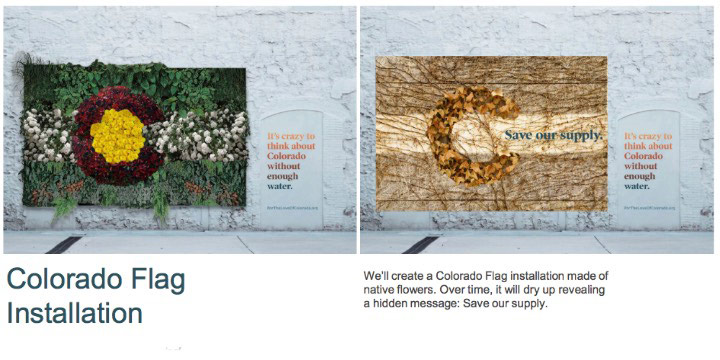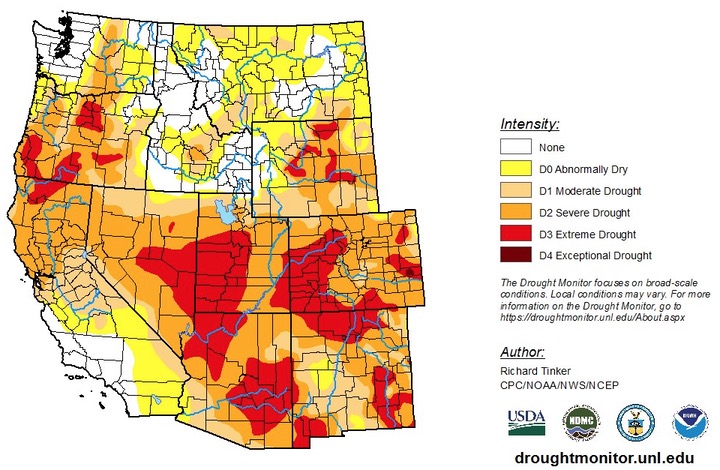There’s so much we don’t understand about the world, and about nature. Yet we profess to have knowledge and understanding.
I heard that Pagosa’s temperature dropped to 34 degrees on Sunday morning — a beautiful morning, two days after the official start of Summer. The nearby mountains, now clothed in emerald green by a extraordinarily cool, wet spring, had been lightly dusted with snow. The days have been unseasonably mild, even though it’s now the 25th of June.
We’ve rarely seen such an abundance of wildflowers.
We are told that the planet is warming, due to an overdose of carbon dioxide generated by human activities, and as a result, the American West will — without a doubt — suffer deepening drought and dangerous water shortages. One of the most successful marketing firms in Colorado — Sukle — has been burning the midnight oil to create images and messages aimed at convincing us that $40 billion in tax expenditures will be needed to solve Colorado’s looming water crisis.
The marketing firm has invented ideas like this one:
“Colorado Flag Installation. We’ll create a Colorado Flag installation made of native flowers. Over time, it will dry up revealing a hidden message: Save our supply.” That is to say, save our water supply. By raising taxes.
There have certainly been years when, by June 25, the hills surrounding my home in Pagosa resembled the image on the right. Brown. Dry.
But this year has been different. The hills, this summer, look very much like the image on the left.
Who can explain this? When the entire world is supposedly suffering from ‘climate change’? When Colorado, in particular, is going to dry up like a field of dead flowers, and blow away in the wind?
If we can’t explain it… how can we plan for the future?
The Board of the San Juan Water Conservancy District (SJWCD) recently set itself a goal: to define the District’s goals. A preliminary list of goals, to be fleshed out in draft form for the SJWCD ‘strategic plan’ over the next few months, was discussed at a recent Board meeting:
A quick survey in early March of [SJWCD] Board Members regarding the primary intended outcome/set goals yielded an emphasis on educating the community on water issues.
Other outcomes/goals included:
- Developing alternatives for how to meet the water needs of the community in the future;
- Establishing goals for how best to utilize the assets of the District in the future;
- Developing realistic planning statistics from which to plan for growth and development;
- Increased fundraising;
- Fully understand the water rights the District currently owns and how best to utilize those moving forward
For a couple of decades, the San Juan Water Conservancy District and the Pagosa Area Water and Sanitation District (PAWSD) had collaborated on one particular method of ensuring sufficient water supplies in the urban/suburban areas of Archuleta County. The chosen method involved the creation of a new water reservoir somewhere in the county. In 2003, the location of that reservoir was assigned to a broad valley northeast of downtown Pagosa Springs — a valley designated on maps as ‘Dry Gulch.’ In 2008, PAWSD put its ratepayers deeply into debt to purchase some of the property in Dry Gulch, with the help of a grant acquired by SJWCD. But a few years later, in 2012, a newly-elected PAWSD Board of Directors placed the Dry Gulch project firmly on the back burner, and ceased its collaborative association with SJWCD.
The Conservancy District continued negotiating with various agencies and entities in hopes of keeping the Dry Gulch Reservoir project viable, but in 2017, local voters rejected a tax increase measure that would have funded continuing work on the Dry Gulch project — now renamed the ‘San Juan River Headwaters Project’. Soon thereafter, SJWCD Board experienced a significant turnover of Board members; the Board President resigned, as did the Board Treasurer; the Board saw the appointment of four new members, two of whom quickly resigned.
Dry Gulch — the San Juan River Headwaters Project — might be dead in the water, so to speak. Or it could be merely slumbering until political changes bring it back to life.
The Conservancy District itself, however, is not dead. It receives property tax funding from properties located within the district, to the tune of — currently — about $75,000 per year.
Recent conversations at the board level suggest that the Board unanimously sees ‘community water education’ as one of its primary goals over the next few years. This is a happy coincidence for me, as editor of the Pagosa Daily Post, because one of my primary journalistic goals is the education of the taxpaying public.
Now, the government board on which I serve has expressed a similar intent.
We understand that ‘education’ can mean different things to different people. To some people, ‘water education’ is the same as ‘water propaganda.’
In my younger years, I worked mainly as a self-employed graphic artist. One of the character traits that led me into that career was a fascination with typography and composition; I was intensely interested in how images and lettering can be combined to deliver a message to the viewer.
When the Colorado business coalition known as ‘For the Love of Colorado’ hired the Denver-based Sukle marketing team to create frightening advertisements about impending water shortages, the marketing geniuses at Sukle came up with a series of simple, graphic messages, as shown above.
“By 2050, our water supply will diminish by 35% while our population doubles.” For example.
We won’t get into the actual mathematics of that particular claim, but what we might want to notice is the way the lettering in these posters changes color, fading from yellow at the top to dark reddish brown at the bottom.
The Sukle marketing team is playing with your subconscious here, or so it appears. They seemingly want you to subconsciously connect their textual message to the colors used by the US Department of Agriculture’s ‘Drought Monitor’ maps whenever Colorado is suffering from severe drought:
“Yellow” means “abnormally dry”.
“Orange” means “severe drought”.
“Dark reddish brown” means “exceptional drought”.
The subliminal message lingering in your mind, after viewing the ‘For the Love of Colorado’ posters, might be: ‘My God, the state of Colorado is destined to become a waterless desert…’
Incidentally, the US Drought Monitor map shown above was found on the University of Nebraska-Lincoln website.
Their most recent map of Colorado shows no drought. Not a bit, anywhere.


